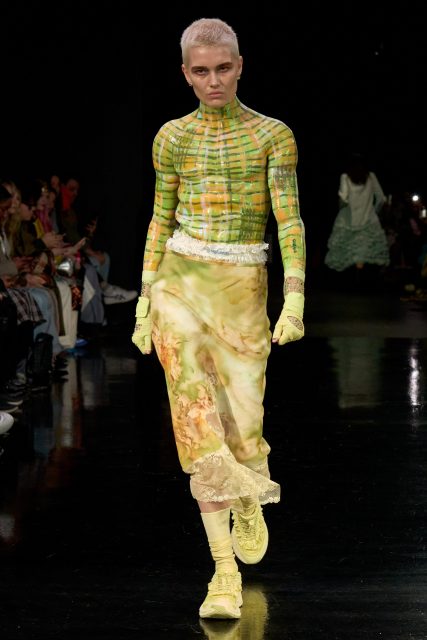Last season, Stuart Vevers celebrated his tenth anniversary at Coach. This season, fall 2024, Vevers admirably demonstrated that he has absolutely no interest in resting on his laurels. Or, for that matter, settling to live off the accolades which have recently come his way: In a tough economic landscape, sales at his Coach have been on the up and up. At a preview a few days before his show, Vevers mentioned that he’s intent on moving sustainability—all the recycling, upcycling, and reevaluating—to the very forefront of his design processes, making it an integral part of his creative expression for Coach. “That sense of creating, designing with relevance and responsibility, and a certain sense of urgency about all this—that’s where my head is,” he said. Essentially, what it means is anything is fair game for his vision of Coach: Newness shellacked with a hyper-glossy perfection isn’t what he has in mind. It’s an approach that has been validated by the experimental side of offshoot label Coachtopia.
“What’s different about how we approach sustainability in the show versus the brand is that generally the show is all about experimentation and trying new things,” he said. “So, we’re pushing ourselves creatively and aesthetically, but also experimenting with sustainability and some things work and some things don’t. Approaching things without fear was a big shift for me. And sometimes seeds of an idea become big ideas within the business later.”
Fall, then, rejoiced in a fantastically spirited celebration of the found and the fucked up, the loveworn and the just plain old worn-worn, an approach which worked across the collection regardless of gender. It looked great. There were weathered coats, slouchy and oversized and slope-shouldered, which looked like they’d been lived in for years; ditto the denims, which look distressed and beaten up (they were) but were also intricately patched together from ones the Coach team thrifted, assemblages of fragments of different life cycles of the humble jean. Also sourced were a gazillion aviator jackets, which were cut up and reconstructed into terrific barn jackets with a gorgeous patina of age. (There were also versions made from new shearling and leather, one swishing with fringe, alongside those of vintage origin.)
Vevers opened and closed the show with black, pink and lilac taffeta evening looks which he’d gone at with the scissors, snipping dresses into tops, then keeping the skirts for other looks, and deftly festooning them with bows, some spangled. There was a distinct Amy Arbus ’80s vibe going on, what with the East Village thrift store cocktailania, the tuxes, the pointy Oxfords and chunky biker boots, but also the ’90s, the era when Vevers first landed in New York. “I’m playing with references from my ’90s experiences in New York with a certain nostalgia,” he said. “But it’s about reinterpreting them with a more inclusive point of view, which I think my Coach has—and which I enjoy.”
The latter could be seen in the geegaws that were hanging from his bags—the NYC yellow cab, the Big Apple apple, the Statue of Liberty, a virtual souvenir-fest of things you can find for sale on every street corner of the city, and in stark contrast to the relative simplicity of the bags—big shoulder totes, sizable holdalls, neat purses hanging from chains, and all in an ever so slightly distressed leather. Of course, not everything here was made from upcycled or recycled materials, but the narrative was that Coach’s vision of making is dependent on shifting the idea that fashion is inherently disposable. The brand has set up facilities so that customers can get their old Coach spiffed up to prolong its life.
Yet perhaps more crucially, Vevers and the brand are moving away from the notion of aspiration which is starting to feel like it’s out of touch and out of date; that we’re only ever satisfied if we’re trading up towards some elusive and fleeting notion of quote-unquote luxury. Instead of mimicking the haute, why not rejoice instead in what you do? Vevers is of the same mind. “I think as an American house, we can do that because the references, the archetypes, are about just that,” he said. “That striving for perfection is not part of what I do today. I’m much more interested in individuality and self-expression.”
Editor
Mark HolgateCredit
Lead Image: Isidore Montag / Gorunway.com

